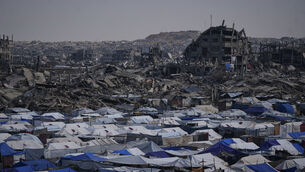Philippines appeals for aid for storm victims
Philippine officials sought international help today to rebuild villages devastated by back-to-back storms that left more than 1,100 people either dead or missing and devastated mostly poor northern agricultural regions.
The storm and typhoon that struck late on Monday and Thursday left 566 people dead and 546 others missing and set off flash floods and landslides that destroyed hundreds of houses, farms, roads and bridges.














